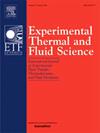Combined polarization and electrophoretic influence on bubble dynamics in leaky dielectric fluids
IF 3.3
2区 工程技术
Q2 ENGINEERING, MECHANICAL
Experimental Thermal and Fluid Science
Pub Date : 2025-08-26
DOI:10.1016/j.expthermflusci.2025.111601
引用次数: 0
Abstract
Electrohydrodynamics (EHD) is a powerful tool for manipulating fluid interfaces. While many studies focus on polarization forces in ideal dielectrics, the behavior of modern leaky dielectric fluids, where free charges and Coulomb forces are significant, remains less understood. This study investigates the dynamics of air bubbles in HFE-7100, a representative leaky dielectric fluid, under DC, polarity-changing, and high-frequency (1 kHz) AC electric fields. High-speed imaging reveals that when the charge relaxation time () is comparable to the bubble lifespan, complex dynamics emerge. Under DC fields, this leads to significant discrepancies in bubble lifespans and waiting times. During polarity reversal, Coulomb forces temporarily counteract buoyancy, pinning bubbles to the surface and creating unique triangular shapes. Conversely, high-frequency AC fields suppress these charge effects, leading to highly consistent, polarization-dominated dynamics, albeit with prolonged surface residence times. These findings demonstrate that free charges are critical in EHD phenomena in leaky dielectric fluids and highlight the limitations of quasi-electrostatic models. This work provides a foundation for refining theoretical models for EHD applications with modern fluids.
耦合极化和电泳对漏电介质中气泡动力学的影响
电流体力学(EHD)是控制流体界面的有力工具。虽然许多研究集中在理想介质中的极化力,但现代泄漏介质流体的行为,其中自由电荷和库仑力是重要的,仍然知之甚少。本文研究了典型漏电介质HFE-7100在直流、变极性和高频(1khz)交流电场作用下的气泡动力学。高速成像表明,当电荷弛豫时间τe与气泡寿命相当时,会出现复杂的动力学现象。在直流磁场下,这导致气泡寿命和等待时间的显著差异。在极性反转期间,库仑力暂时抵消浮力,将气泡固定在表面并形成独特的三角形。相反,高频交流电场抑制这些电荷效应,导致高度一致的极化主导动力学,尽管表面停留时间延长。这些发现表明,自由电荷在泄漏介质流体中的EHD现象中是至关重要的,并突出了准静电模型的局限性。这项工作为完善现代流体EHD应用的理论模型奠定了基础。
本文章由计算机程序翻译,如有差异,请以英文原文为准。
求助全文
约1分钟内获得全文
求助全文
来源期刊

Experimental Thermal and Fluid Science
工程技术-工程:机械
CiteScore
6.70
自引率
3.10%
发文量
159
审稿时长
34 days
期刊介绍:
Experimental Thermal and Fluid Science provides a forum for research emphasizing experimental work that enhances fundamental understanding of heat transfer, thermodynamics, and fluid mechanics. In addition to the principal areas of research, the journal covers research results in related fields, including combined heat and mass transfer, flows with phase transition, micro- and nano-scale systems, multiphase flow, combustion, radiative transfer, porous media, cryogenics, turbulence, and novel experimental techniques.
 求助内容:
求助内容: 应助结果提醒方式:
应助结果提醒方式:


